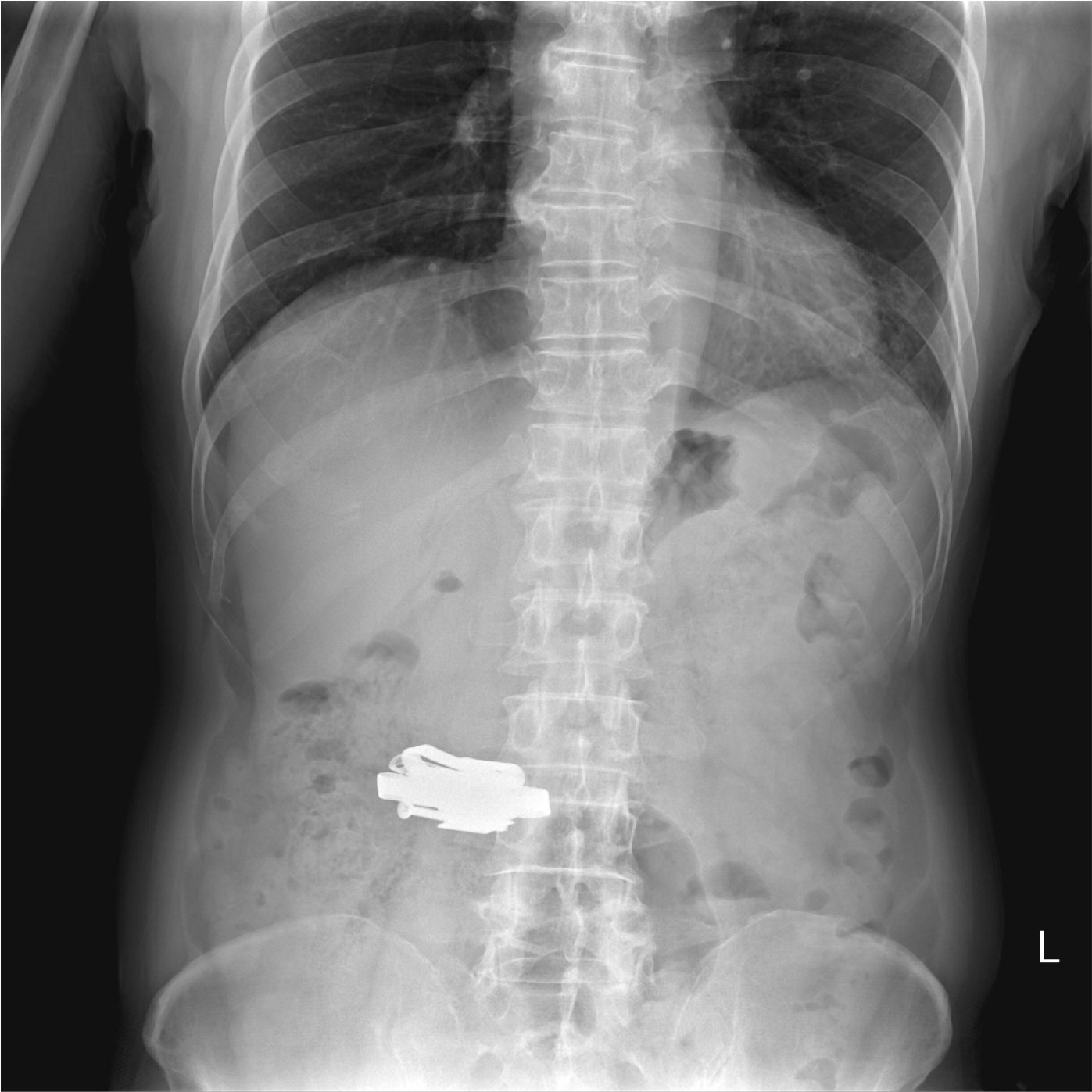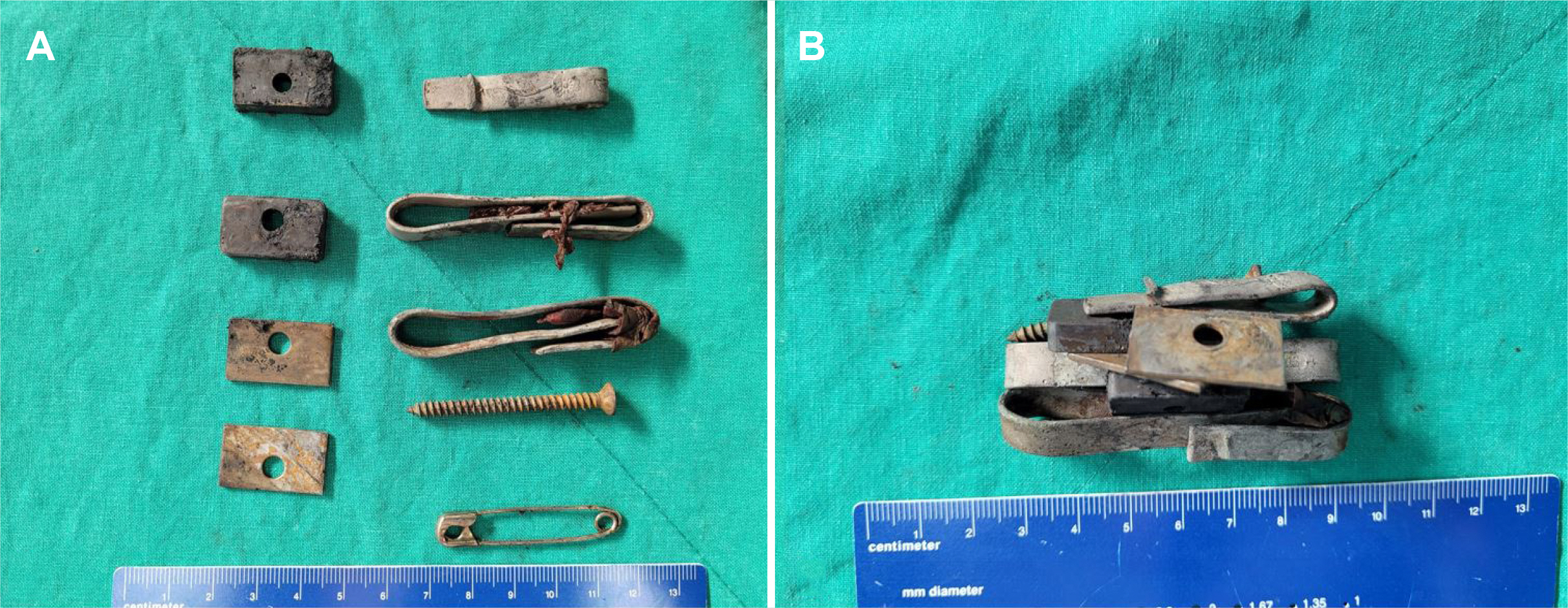Korean J Gastroenterol.
2023 Oct;82(4):198-201. 10.4166/kjg.2023.087.
A Gastric Magnetic Foreign Body Incidentally Detected Several Years after Ingestion
- Affiliations
-
- 1Department of Internal Medicine, Pusan National University College of Medicine, Busan, Korea
- 2Biomedical Research Institute, Pusan National University Hospital, Busan, Korea
- KMID: 2547291
- DOI: http://doi.org/10.4166/kjg.2023.087
Abstract
- Foreign body ingestion is commonly seen in children. However, occasionally it may also be seen among adults and is often associated with intellectual disability, psychiatric disorders, and alcoholism. Ingestion of a magnetic foreign body may cause complications such as gastrointestinal tract perforation, wherein emergency endoscopic removal of the foreign body is generally required. Here, we report a rare case of a 59-year-old male with an intellectual disability and psychiatric disorder in whom metallic objects in the stomach cavity were accidentally discovered during abdominal CT. Esophagogastroduodenoscopy revealed several metallic objects attached to two magnets, which had been ingested several years before and had remained in the stomach cavity. The magnets and metallic objects were safely removed endoscopically using rat-tooth forceps without complications.
Keyword
Figure
Reference
-
1. Sugawa C, Ono H, Taleb M, Lucas CE. 2014; Endoscopic management of foreign bodies in the upper gastrointestinal tract: A review. World J Gastrointest Endosc. 6:475–481. DOI: 10.4253/wjge.v6.i10.475. PMID: 25324918. PMCID: PMC4198392.
Article2. Birk M, Bauerfeind P, Deprez PH, et al. 2016; Removal of foreign bodies in the upper gastrointestinal tract in adults: European Society of Gastrointestinal Endoscopy (ESGE) Clinical Guideline. Endoscopy. 48:489–496. DOI: 10.1055/s-0042-100456. PMID: 26862844.
Article3. Li C, Yong CC, Encarnacion DD. 2019; Duodenal perforation nine months after accidental foreign body ingestion, a case report. BMC Surg. 19:132. DOI: 10.1186/s12893-019-0594-5. PMID: 31500608. PMCID: PMC6734462.
Article4. Kim J, Ahn JY, So S, Lee M, Oh K, Jung HY. 2017; Fluoroscopy-guided endoscopic removal of foreign bodies. Clin Endosc. 50:197–201. DOI: 10.5946/ce.2016.085. PMID: 28008164. PMCID: PMC5398372.
Article5. Waters OR, Daneshmend T, Shirazi T. 2011; An incidental finding of a gastric foreign body 25 years after ingestion. BMJ Case Rep. 2011:bcr1020115001. DOI: 10.1136/bcr.10.2011.5001. PMID: 22674959. PMCID: PMC3229415.
Article6. Liu S, Li J, Lv Y. 2012; Gastrointestinal damage caused by swallowing multiple magnets. Front Med. 6:280–287. DOI: 10.1007/s11684-012-0207-5. PMID: 22886320.
Article7. Hussain SZ, Bousvaros A, Gilger M, et al. 2012; Management of ingested magnets in children. J Pediatr Gastroenterol Nutr. 55:239–242. DOI: 10.1097/MPG.0b013e3182687be0. PMID: 22785419.
Article8. Crespo Pérez L, Angueira Lapeña T, Defarges Pons V, et al. 2008; [A rare cause of gastric outlet obstruction: Bouveret's syndrome]. Gastroenterol Hepatol. 31:646–651. Spanish. DOI: 10.1016/S0210-5705(08)75813-8. PMID: 19174082.9. Fung DF, Shanmugam V. 2016; Uncommon cause for ileocolic fistulation and caecal perforation following multiple magnet ingestion in an adult. J Surg Case Rep. 2016:rjw204. DOI: 10.1093/jscr/rjw204. PMID: 27887015. PMCID: PMC5159023.
Article
- Full Text Links
- Actions
-
Cited
- CITED
-
- Close
- Share
- Similar articles
-
- Gastric Pseudotumoral Lesion Caused by a Fish Bone Mimicking a Gastric Submucosal Tumor
- Small Bowel Complication Due to Magnetic Foreign Body Ingestion in Childhood
- Management of Gastrointestinal Foreign Body Ingested during Dental Procedure
- Prevention and management of foreign body ingestion and aspiration during the dental treatment
- A Case of Ingested Two Magnets Attracted Each Other that were Holding Gastric Mucosa




